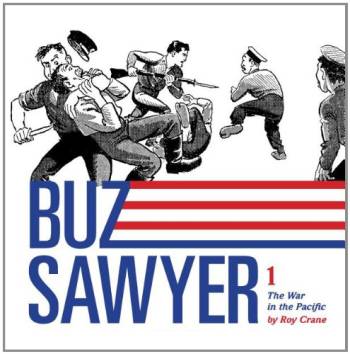 Home > CR Reviews
Home > CR Reviews Buz Sawyer Volume One: The War In The Pacific
posted January 31, 2011
Buz Sawyer Volume One: The War In The Pacific
posted January 31, 2011

 Creators:
Creators: Roy Crane, Jeet Heer
Publishing Information: Fantagraphics, hardcover, 240 pages, February 2011, $35
Ordering Numbers: 9781606993620 (ISBN13)
This was an odd reading experience. There's no doubt in anyone's mind that Roy Crane was a first-class cartoonist, frequently making panels on the newspaper page that were absolutely to die for, stop-and-study moments of the kind that inspire the best students and discourage the worst. There are times when reading these rousing adventures of Navy pilot Buz Sawyer and his support man Roscoe Sweeney that it's hard to believe anything this striking ever appeared on the comics pages, let alone in support of an ongoing war. Crane's drawing ability was almost its own brand of American exceptionalism, and you couldn't guess where he's whip his point-of-view next, or what piece of Army equipment would be rendered in such spot-on fashion it seemed it had been around a half-century, or what variation of Crane's beautiful woman would cross our heroes' path next. It works so well all in one place that it's nearly impossible to believe that people kept strip after strip around in their heads so as to string the narrative along that way.
Still, I think this first volume suggests a potential reason why
Buz Sawyer isn't considered the adventure masterpiece the way some view
Wash Tubbs and Captain Easy. Launched during wartime at a point where the outcome of the war was still very much in doubt, and Crane's graduation from the small-town papers favored by NEA to the biggest markets, the characters feels like a pitch rather than something that developed on the page. Sawyer has an almost comedic fixation on women -- the funniest panel in the whole collection comes in Crane's rendering of a ridiculous dream Sawyer has while stuffed into a shallow grave for protection against snipers -- but mostly he's dull. The ex-Texas football player and much-loved son of small-town, salt-of-the-earth types does very little that surprises, from the way he offers loyalty to those who deserve it to the manner in which he indulges in the occasional rash but ultimately harmless act. An interminable home-front storyline ditches the relatively fascinating details of military life -- really little more than general impressions, but still a rich setting -- for a standard, small-town, soap opera set-up. It's his toughest campaign, but Sawyer never surprises and rarely delights. He does the job.
That's not to say this isn't page after page of first-class cartooning. It's rather that in noting those scenes that don't quite fit in perfectly to the adventure and soap opera paradigms Crane favors stick out with such alacrity you can't help but wonder where a looser, more profane, less respectful approach might have taken the reader. A moment where Roscoe Sweeney slinks away from the Sawyer family home after being chased off by a prospective wife's horrible mother becomes memorable in that Sawyer doesn't make some dramatic gesture to fix it, and his failure to do so feels more real than any righteous confrontation could have. A 1945 subplot where a tight-assed commander has placed Sawyer on an eerily accurate list of pilots that, based on their habits and proclivities, seem likely to lose their planes and their lives sings because of its choppy, dark undertones. The Atom Bomb takes care of that particular piece of business. War over. Reading a page or two of this material at a time seems like more than enough to drink in these ridiculously skilled bits of cartooning art; anything more and you feel like you're being dragged into b-movie narrative, something decided on beforehand. Add to this the general unease one may feel when wondering if it's a generational impulse through which World War II narratives hold special power, and the outright cringing that may occur when one encounters the way that Crane -- who to his credit apparently later regretted it -- treated black people and Asians through broad, unflattering caricature. Jeet Heer's typically thorough job in providing context will clue you as to why all of this was happening, but that doesn't mean these aren't strikes against the material, and that they may temper the enthusiasm with which you see unfold Crane's largely humane vision of the war effort and, of course, the rapturous power he frequently displayed putting ink on the page. It's because of the calculation of
Buz Sawyer that we're harder on those elements left out of the equation.


